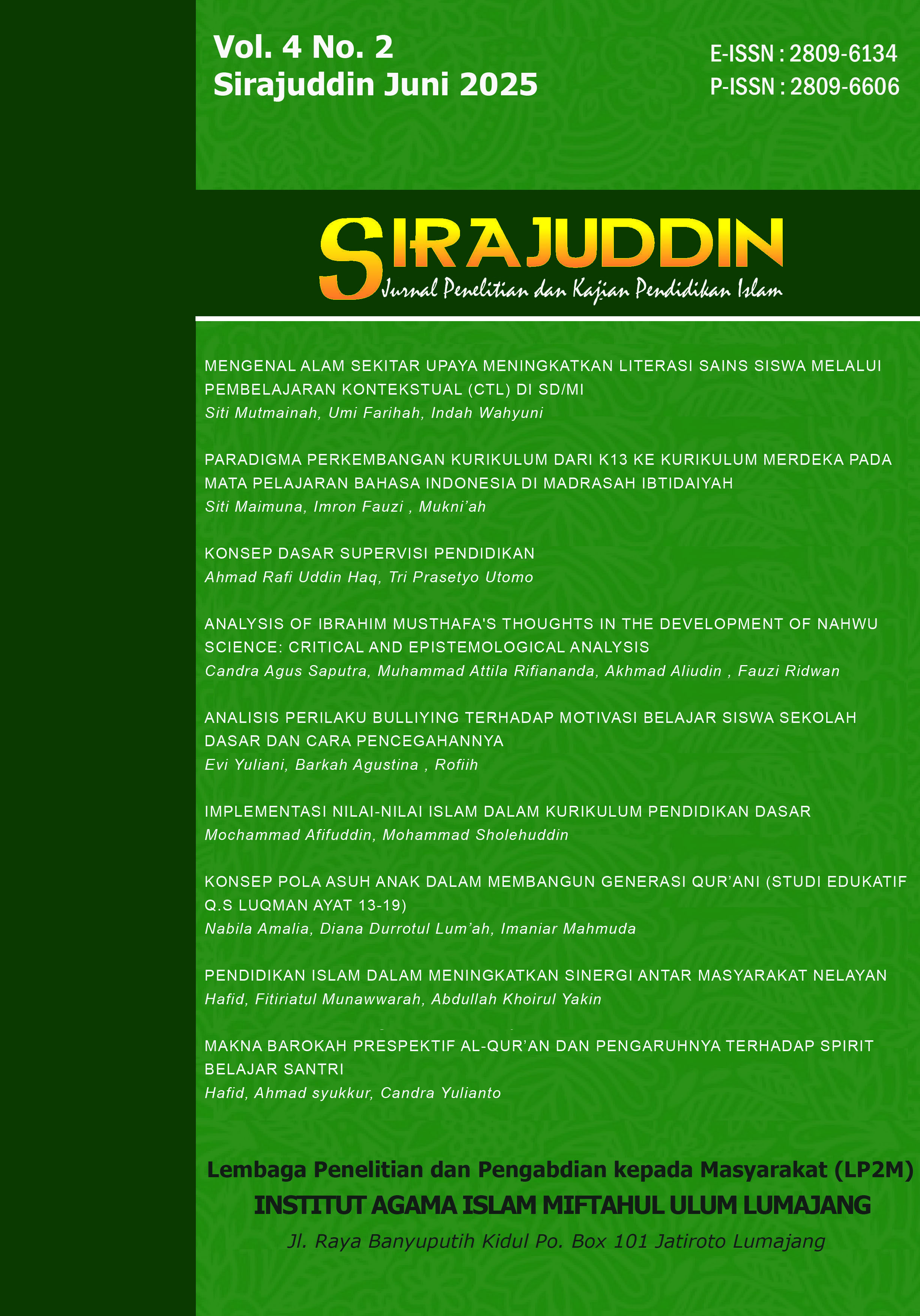MENGENAL ALAM SEKITAR UPAYA MENINGKATKAN LITERASI SAINS SISWA MELALUI PEMBELAJARAN KONTEKSTUAL (CTL) DI SD/MI
DOI:
https://doi.org/10.55120/sirajuddin.v4i2.2182Keywords:
Literasi sains, pembelajaran kontekstual, alam sekitar, sekolah dasarAbstract
This study aims to describe efforts to improve students’ science literacy through contextual learning that connects science materials with the natural environment surrounding elementary school students. The research employed a descriptive qualitative approach and was conducted at SDN Mangli 1 Jember and MIN 3 Jember. Informants included the school principals, science teachers, students’ parents, and students in grades IV and V. Data were collected through in-depth interviews, observation, and documentation, and analyzed thematically using the Miles and Huberman model with source and technique triangulation. The findings revealed that efforts to improve science literacy were carried out by actively involving students in observation, simple experiments, and reflection on natural phenomena in their surroundings. Contextual learning was implemented through the integration of CTL (Contextual Teaching and Learning) principles such as inquiry, learning community, and authentic assessment. The school environment was utilized as a learning resource that encouraged student engagement and the development of science process skills. Learning activities that connected subject matter to real-life contexts effectively fostered curiosity, critical thinking skills, and environmental awareness. This study recommends that teachers consistently apply locally contextualized learning as a strategy to enhance science literacy at the elementary level. Furthermore, involving parents and the community is essential to support more meaningful science learning for students.
References
Astria, I. N., Astawa, I. N., & Putra, I. M. A. (2024). Pengembangan Bahan Ajar IPA Berbasis Kontekstual pada Siswa Sekolah Dasar. Biochephy: Journal of Science Education, 3(1), 12–22. https://doi.org/10.59653/biochephy.v3i1.1434
Creswell, J. W. (2014). Research Design: Qualitative, Quantitative, and Mixed Methods Approaches (4th ed.). SAGE Publications.
Evalina, E. (2020). Inovasi Media Pembelajaran IPA Berbasis Kontekstual untuk Meningkatkan Literasi Sains Siswa Sekolah Dasar. Jurnal Basicedu, 4(3), 560–568. https://doi.org/10.31004/basicedu.v4i3.349
Fatmala, D., Suryani, N., & Prastowo, T. (2017). Pengembangan Pembelajaran Kontekstual untuk Meningkatkan Literasi Sains Siswa Sekolah Dasar. Jurnal Prima Edukasia, 5(2), 134–144. https://doi.org/10.21831/jpe.v5i2.14635
Miles, M. B., Huberman, A. M., & Saldaña, J. (2014). Qualitative Data Analysis: A Methods Sourcebook (3rd ed.). SAGE Publications.
Nofiana, R., & Julianto, T. (2018). Pembelajaran Berbasis Keunggulan Lokal dalam Meningkatkan Literasi Sains dan Kepedulian Lingkungan. Jurnal Ilmiah Pendidikan Fisika Al-Biruni, 7(2), 205–218. https://doi.org/10.24042/jpifalbiruni.v7i2.2875
OECD. (2019). PISA 2018 Results (Volume I): What Students Know and Can Do. OECD Publishing. https://doi.org/10.1787/5f07c754-en
Patton, M. Q. (2002). Qualitative Research & Evaluation Methods (3rd ed.). Thousand Oaks, CA: SAGE Publications.
Windyariani, R., Rachmadyanti, P., & Mufit, F. (2020). Pengembangan Bahan Ajar IPA Kontekstual Berbasis Kreativitas untuk Siswa SD. Bioedukatika: Jurnal Pendidikan Biologi, 8(2), 101–110. https://doi.org/10.26555/bioedukatika.v8i2.5326
Yuliati, L., & Suryanti, S. (2017). Pembelajaran Kontekstual untuk Meningkatkan Kemampuan Literasi Sains Siswa Sekolah Dasar. Jurnal Penelitian Ilmu Pendidikan, 10(1), 14–22. https://ejournal.upi.edu/index.php/penailmiah/article/view/10656










